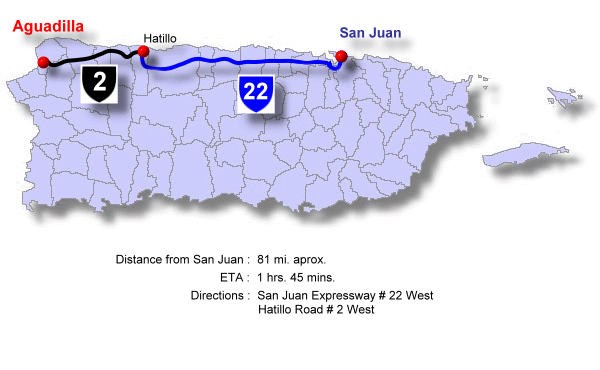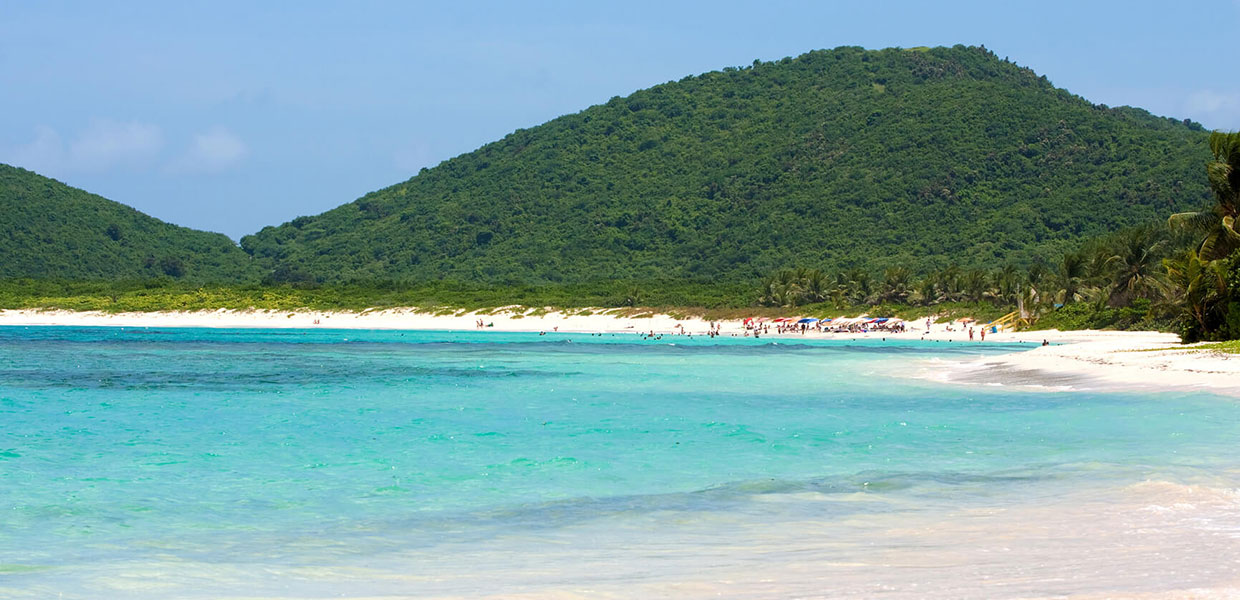
Aguadilla, Puerto Rico
The Water Hole Villa

Destroyed by a sunami in 1918
Aguadilla (ah-gwah-DEE-yah) is known popularly as the “city of springs.” The nickname comes from the spring or Río Chiquito, known today as the Parterre. Aguadilla is also known as the “town of sharks”, the “new garden of the Atlantic” and the place where “even the stones sing”.
A town of traditions, Aguadilla celebrates a festival in honor of its patron saint, Saint Charles Borromeo, in November.
Aguadilla is located on the northwest coast of the island. It is bordered on the north by the Atlantic Ocean and Isabela; on the south by Moca and Aguada; on the east by Isabela and Moca; and on the west, once again by the Atlantic Ocean.
The largely flat terrain geographically is part of the northern coastal plains. Forestry resources include the Maleza Alta mangrove area, where there are black and white mangroves, providing a habitat for numerous species.
The economy of the town today is based on pharmaceuticals, rubber, plastics, leather, textiles, metals, wood, electronic equipment and food processing. The town’s beaches are also known for their beauty and are frequented by surfers, divers and kayakers. The town has a golf course at Punta Borinquen, an inn and tourist resort, and an art museum.
Foundation:
Don Luis de Córdova founded Aguadilla in 1775 when it was separated from Aguada. At the beginning it had three main streets and a small population. Aguadilla is also known as the "La Villa del Ojo del Agua" (The Water Hole Villa), "El Pueblo de los Tiburones" (Town of the Sharks), and recently "El Nuevo Jardín del Atlántico" (The New Garden of the Atlantic).
The name of Aguadilla is derived from the indian word "Guadilla or Guadiya", which means garden. In 1861 it received the denomination of Villa, years later Aguadilla became to be the head of the third Senatorial District, made up of Aguada, Isabela, Lares, Moca, Rincón and San Sebastián.
Location:
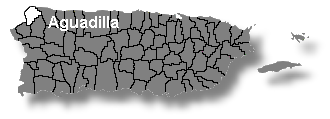 The municipality of Aguadilla is located at the northwest corner of Puerto Rico. Bordering it are: the Atlantic Ocean and Isabela to the north, Moca and Aguada to the south, Isabela and Moca to the east, and the Atlantic Ocean to the west.
The municipality of Aguadilla is located at the northwest corner of Puerto Rico. Bordering it are: the Atlantic Ocean and Isabela to the north, Moca and Aguada to the south, Isabela and Moca to the east, and the Atlantic Ocean to the west.
Area:
92.3 sq km / 35.5 sq mi
Population:
64,685 (census 2000)
Population Density:
700.8 per sq km / 1,826.9 per sq mi
People are known as:
Aguadillanos
Aguadilla is also known as:
La Villa del Ojo de Agua (The Water Hole Villa)
El Pueblo de los Tiburones (Shark Town)
El Nuevo Jardín del Atlántico (The New Atlantic Garden)
Hasta Donde Las Piedras Cantan (Where Even The Stones Sing)
Wards: Aguadilla, Puerto Rico

| Censo 2000: Population by Wards - Aguadillaa | Habitants |
|---|---|
| Aguadilla Pueblo | 4,884 |
| Arenales | 1,038 |
| Borinquen | 8,386 |
| Caimital Alto | 3,656 |
| Caimital Bajo | 5,277 |
| Camaceyes | 12,138 |
| Ceiba Alta | 566 |
| Ceiba Baja | 2,420 |
| Corrales | 8,546 |
| Guerrero | 3,366 |
| Maleza Alta | 1,613 |
| Maleza Baja | 3,058 |
| Montaña | 4,027 |
| Palmar | 2,136 |
| Victoria | 2,043 |
| Total | 64,685 |
Source: Censo 2000
Patron:
San Carlos Borromeo
San Carlos Borromeo Parish
Apartado 238
Aguadilla, P.R. 00605
Tel. (787) 891-0575
Mass Schedule:
Daily: 7:00am & 5:30pm
Saturday: 4:00pm & 7:00pm
Sunday: 7:00, 8:30, 10:00am & 4:00p
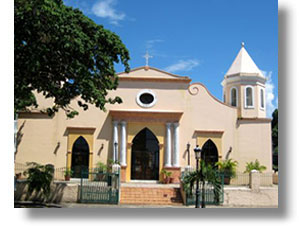
Topography:
Aguadilla belongs to the Western Costal Valley. Its terrain is mostly flat. The most outstanding hills are Jiménez (728 feet) and El Viñet (689 feet).
Hydrography:
Culebrinas River
Economy:
Textiles, chemicals, paper products, electronic equipment, fruit, cattle and sugar.
Average Salary:
$314.28 weekly (1998)
Flag:
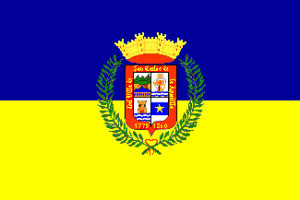 The flag is light blue over yellow with the Coat of Arms and laurels in the center.
The flag is light blue over yellow with the Coat of Arms and laurels in the center.
The flag was designed in 1972 following the recommendations of the Puerto Rican Institute of Culture for the occasion of the 200th Anniversary of the city's foundation. It consists of two horizontal bands of equal size, blue the upper one and gold (yellow) the lower one, the predominant colors of the Coat of Arms placed at the center of the flag.
Coat Of Arms:
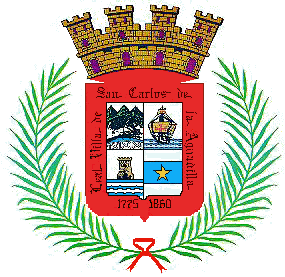 The shield's arms refer to the history of Aguadilla. The first quarter (upper left) presents the famous "Ojo de Agua" (Water Hole) behind the Jaicoa Mountains. The second quarter (upper right) shows the image of a "nao" or vessel that stands for the many ships that made Aguadilla their seaport in past centuries and with reference to the discovery of Puerto Rico by Christopher Columbus. (Another contested site of the landing). The third quarter (lower left) illustrates a tower raised from the waters due to the battles at Fuerte de la Concepción (Fort of the Conception), where English and Colombian pirate's attacks were repelled in the XVII and XIX centuries. The fourth quarter has a five-point star in reference to the many Aguadillan intellectuals that have given prestige to the arts, sciences, writings, military, and legislature; it is an _expression of light and clarity.
The shield's arms refer to the history of Aguadilla. The first quarter (upper left) presents the famous "Ojo de Agua" (Water Hole) behind the Jaicoa Mountains. The second quarter (upper right) shows the image of a "nao" or vessel that stands for the many ships that made Aguadilla their seaport in past centuries and with reference to the discovery of Puerto Rico by Christopher Columbus. (Another contested site of the landing). The third quarter (lower left) illustrates a tower raised from the waters due to the battles at Fuerte de la Concepción (Fort of the Conception), where English and Colombian pirate's attacks were repelled in the XVII and XIX centuries. The fourth quarter has a five-point star in reference to the many Aguadillan intellectuals that have given prestige to the arts, sciences, writings, military, and legislature; it is an _expression of light and clarity.
The inscription thereupon refers to the granting of the title of "Loyal Villa", in 1860, by Queen Elizabeth II and that corresponded to the cooperation that Aguadilla gave to Spain during the war in Africa. The green boughs refer to the palms that the Holy Virgin of Victory carries. The crown has four towers signifying its status of Villa. The colors stand for the following: red for courage, fearlessness, intrepidity (boldness), and honor; blue, the classic sea color, for serenity and sweetness; green for hope, abundance and liberty; purple for the dignity of the citizens; gold for wealth, faith and constancy (steadfastness). The white background stands for temperance and kindliness.
Events:
- Three Kings’ Day Festival – January
- A night for love in the Atlantic garden – February
- Anniversary of José de Diego – April
- Puerto Rican Kite Festival – April
- Flower and Song for Mothers – May
- Beach Festival – May
- Song and Poetry for Fathers – June
- Placido Acevedo Music Festival – June
- Saint John’s Eve – June
- Festival of Our Lady of Mount Carmel – July
- Christmas illumination – October
- Aguadilla Harbor Festival (patron saint’s festival) – November
- Festival of the Discovery – November
- Christmas caroling – December
- Christmas parade – December
- Rafael Hernández Music Festival – December
- Homecoming on the town square – last Sunday of the month
Places To Visit:
- Aguadilla Ice Skating Arena
- Old sugar dock
- Aguadilla bowling alley
- City Hall
- Stone house – Punta Borinquen Lighthouse
- Indian Fountain
- The Fountain of Youth
- Colón Park
- Fort La Concepción
- Las Cascadas Water Park
- Saint Charles Borromeo Church
- El merendero
- Monument to Rafael Hernández
- Monument to Fishermen
- Aguadilla Art Museum
- Parterre Spring
- Fishermen’s Plaza
- Rafael Hernández Town Square
- Punta Borinquen Golf Course
- Ruins of the old Spanish lighthouse
- Luis Raúl Estévez Skate & Splash Park
Beaches:
- Crash Boat Beach
- Survival Beach
- La Ponderosa Beach
- La Poza Beach
- La Saldinera Beach
- Tabletop Beach
Distinguished Citizens:
- María Bibiana Benítez y Constanza – considered to be the first woman poet in Puerto Rico, a great aunt of José Gautier-Benítez. Her works include: La ninfa de Puerto Rico (1831), Dialogo alegórico (1858), and La cruz del Morro (1862).
- Amalia Ceide – teacher, journalist and poet. She was a member of the Puerto Rico Atheneum and the Puerto Rico Writers Association. Her literary works include Interior (1936), Cuando el cielo sonríe (1946), Agustín Stahl (1969), among others.
- José de Diego y Martínez – public speaker, poet, jurist, political figure, attorney, and an ardent defender of independence for Puerto Rico. He was a member of the Chamber of Delegates from 1902 until his death in 1918. In 1907 he became president of that legislative body until the Jones Act, he also presided the new House of Representatives until 1918. De Diego was president of the Puerto Rico Atheneum (1915–16) and the Association of Writers and Artists. He founded the Instituto Universitario José de Diego (1915) and the Academia Antillana de la Lengua (1916), while advocating for Spanish adopted as the language of instruction in the public schools. His works of poetry include Sor Ana (1887), Cantos de rebeldía (1916), Cantos de Pitirre (1950, posthumous) among others.
- Monserrate Deliz – educator, writer, and folklorist. Deliz wrote Cantos Infantiles.
- Esther Feliciano Mendoza – Doctor of philosophy and teacher, she was distinguished as Woman of Puerto Rico by the Union of American Women in 1983. Among other works, she published Nanas (1945), Arcoiris (1951) and Sinfonía de Puerto Rico (1970), the latter receiving an award from the Instituto de Literatura Puertorriqueña.
- Jesús Figueroa – Composer and musician, Figueroa founded a music academy, which he directed until his death. He was awarded the National Prize by the Institute of Puerto Rican Culture. As a composer of many danzas and zarzuelas, he was renowned for musical works such as Nueva Era, Borinquen, and A Carmen.
- Rafael Hernández – the most important Puerto Rican musician and composer of the 20th century. His early work include the songs Pobre Borinquen, El buen borincano, Mamá, Borinquen me llama, and Campanitas de cristal. While living in New York he formed the Trío Borinquen and traveled all over America with hit songs such as Capullito de Alelí and Silencio. In 1934, Hernández organized a quartet by the name of Victoria. The Lamento borincano, a deeply patriotic work, garnered worldwide fame for Hernández.
- José de Jesús-Esteves – attorney, poet, and journalist. De Jesús collaborated with periodicals such as Puerto Rico Ilustrado and La Democracia. His works include Besos y plumas, Crisálidas, Ronda de ánforas, Sauce lírico, and Alma adentro.
- Carmen Gómez-Tejera – professor and essayist.
- Miguel A. García-Méndez – attorney, banker, and political figure. His very active political career included being a member of the House of Representatives from 1928 to 1940; first under the Alianza Puertorriqueña (1928 – 1932), and later, as president of that body, under the Republican Union Party (1933 – 1940). In 1952, he founded the Republican Statehood Party, which he presided until 1968. During that period he represented his party in the Puerto Rico senate. In addition, he was a member of the Constitutional Assembly from 1951 to 1952.
- Manuel Méndez-Ballester – writer, journalist, and political figure. Mendez was a member of the House of Representatives from 1962 to 1968. He collaborated with newspapers such as El Nuevo Día. His works include Isla Cerrera (1937), El clamor de los surcos (1938), Tiempo muerto (1940), Encrucijada (1958), Bienvenido Don Goyito (1968), and El Circo (1975), among others.
- Ana Roque de Duprey – educator, writer, and feminist. Roque founded the Liceo Ponceño (1901). She wrote Explicaciones de gramática castellana (1889) and Geografía universal (1894), among other works.
- Agustín Stahl – botanist, historian and physician. Stahl thoroughly studied the fauna and flora of Puerto Rico, receiving many academic awards abroad. He also created a museum of natural history. Stahl’s published works include Informe sobre la enfermedad de la caña de azúcar (1880), Los indios borincanos (1889), La fecundidad de la mujer en Puerto Rico (1892) and Fundación de Aguadilla (1910).
Public Schools Sorted by Educational Levels.
Mayagüez Region
Aguadilla District
| Name | Level | Telephone | Address |
| Elementary | |||
| ANA JAVARIZ | K-6 | (787) 891-2260 | PO Box 5254, P.R. 00603-0000 |
| ANTONIO BADILLO HERNÁNDEZ | K-6 | (787) 890-3350 | PO Box 797, P.R. 00690- |
| CABAN | K-5 | (787) 891-2077 | PO Box 4024, P.R. 00605-4024 |
| CARMEN GÓMEZ TEJERA | K-6 | (787) 891-0810 | PO Box 98, P.R. 00605-0000 |
| DR. AGUSTIN STAHL | K-6 | (787) 891-1000 | PO Box 1807, P.R. 00605-1807 |
| ELADIO J. VEGA | PK-6 | (787) 891-0730 | PO Box 566, P.R. 00605-0000 |
| EXTENSION BORINQUEN | K-4 | (787) 891-0484 | PO Box 605 703, P.R. 00605-0000 |
| HOMERO RIVERA SOLA | K-6 | (787) 891-8064 | PO Box 4022, P.R. 00605-0000 |
| JOSÉ ACEVEDO ÁLVAREZ | K-6 | (787) 882-1400 | PO Box 5225, P.R. 00605-5225 |
| JOSÉ DE DIEGO | K-6 | (787) 891-0754 | PO Box 4934, P.R. 00605-4934 |
| LUCIA CUBERO | K-6 | (787) 891-2877 | PO Box 3427, P.R. 00605-0000 |
| LUIS MUÑOZ RIVERA | K-6 | (787) 891-0862 | PO Box 250339, P.R. 00605-0000 |
| MANUEL CORCHADO | K-6 | (787) 891-8510 | PO Box 5236, P.R. 00605-0000 |
| RAFAEL CORDERO | K-6 | (787) 891-0100 | PO Box 98, P.R. 00605-0000 |
| RAFAEL FABIAN | K-6 | (787) 877-6590 | PO Box 1857, P.R. 00605- |
| RAMÓN RODRÍGUEZ | K-6 | (787) 882-9382 | PO Box 5225, P.R. 00605-5225 |
| Intermediate | |||
| ANTONIO BADILLO HERNÁNDEZ | 7-9 | (787) 890-3360 | PO Box 68, P.R. 00690- |
| CENTRO PRE-VOCACIONAL | EE | (787) 819-4620 | PO Box 3744 Caimital Alto, P.R. 00603-0000 |
| DR. RAFAEL DEL VALLE | 7-9 | (787) 891-0620 | PO Box 98, P.R. 00605-0000 |
| ESTHER FELICIANO MENDOZA | 7-9 | (787) 890-2418 | PO Box 250299, P.R. 00604-0000 |
| JOSÉ DE DIEGO | 7-9 | (787) 891-2220 | PO Box 1945, P.R. 00605-0000 |
| Jr. & High School | |||
| CENTRO DE ADIESTRAMIENTO Y BELLAS ARTES | 7-12 | (787) 890-2008 | PO Box 250041, P.R. 00604-0041 |
| Jr. High | |||
| SU ADAMS | K-9 | (787) 891-9170 | Aguadilla Shopping Center, P.R. 00605 |
| High School | |||
| BENITO CEREZO MÁRQUEZ | 10-12 | (787) 891-5000 | PO Box 250434, P.R. 00604-0434 |
| JUAN SUÁREZ PELEGRINA (NUEVA) | 10-12 | (787) 890-2320 | PO Box 98, P.R. 00605-0000 |
| SALVADOR FUENTES | 10-12 | (787) 890-5600 | PO Box 250290, P.R. 00604-0296 |
Hymn:
Playita Aguadillana by Rafael Hernández Marín
Aguadilla Querida,
Barrio del Tamarindo
cueva de golondrinas
cuajadita de nidos,
donde las piedras cantan
junto a los Tres Amigos
y el Cerro de las Amigas
es un mudo testigo.
Somos por ti boricuas
y por tus playas
fue donde llegó la vida
a nuestro bello Edén.
Mi playita aguadillana
nadie podrá olvidar
que por ti es que
se llama Borinquen,
Borinquen, la islita
más hermosa
del antillano mar.

